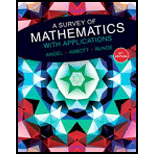
Concept explainers
Electing the Club President The Sailing Club of Lakeport is holding an election to choose the club president. The 42 votes were cast as follows: Comstock, 20 votes, Owens, 15 votes, and Glazer, 7 votes.
- a. Using the plurality method, which candidate is elected president?
- b. Did this candidate receive a majority of votes?
(a)
To find: The candidate who is elected as a president by using the plurality method.
Answer to Problem 1RE
The Comstock wins the election with most votes 20.
Explanation of Solution
Given:
The sailing club of Lakeport is holding an election to choose the club. The 42 votes were cast as follows: Comstock, 20 votes; Owens, 15 votes; and Glazer, 7 votes.
Voting method used:
Plurality voting method:
1. Each voter votes for one candidate.
2. The candidate receiving the most votes is declared the winner.
Calculation:
From the given, it is noticed that the votes received by the three candidates are 20, 15 and 7.
Among three the Comstock receives the most number of votes as compare to other two candidates
By the plurality method, the Comstock wins the president election with most number of 20 votes.
Therefore, the Comstock wins the election with most number of votes as 20.
(b)
To Check: Whether the Comstock receives the majority of votes or not.
Answer to Problem 1RE
The Comstock received only 20 votes which is not a majority of votes.
Explanation of Solution
Given that the total number of votes is 42.
Then the candidate to acquire a majority of votes they should receive a majority of 22 or more number of votes.
It is known that the majority out of 42 votes is 22 or more votes.
But Comstock received only 20 votes which is not the majority of votes out of 42 votes.
That is, it is clear that the candidate does not reach the vote 22.
Therefore, it is concluded that the Comstock received only 20 votes which is not a majority of votes.
Want to see more full solutions like this?
Chapter 14 Solutions
A Survey of Mathematics with Applications (10th Edition) - Standalone book
- Suppose that a particle moves along a straight line with velocity v (t) = 62t, where 0 < t <3 (v(t) in meters per second, t in seconds). Find the displacement d (t) at time t and the displacement up to t = 3. d(t) ds = ["v (s) da = { The displacement up to t = 3 is d(3)- meters.arrow_forwardLet f (x) = x², a 3, and b = = 4. Answer exactly. a. Find the average value fave of f between a and b. fave b. Find a point c where f (c) = fave. Enter only one of the possible values for c. c=arrow_forwardThe following data represent total ventilation measured in liters of air per minute per square meter of body area for two independent (and randomly chosen) samples. Analyze these data using the appropriate non-parametric hypothesis testarrow_forward
- each column represents before & after measurements on the same individual. Analyze with the appropriate non-parametric hypothesis test for a paired design.arrow_forwardShould you be confident in applying your regression equation to estimate the heart rate of a python at 35°C? Why or why not?arrow_forwardGiven your fitted regression line, what would be the residual for snake #5 (10 C)?arrow_forward
- Calculate the 95% confidence interval around your estimate of r using Fisher’s z-transformation. In your final answer, make sure to back-transform to the original units.arrow_forwardCalculate Pearson’s correlation coefficient (r) between temperature and heart rate.arrow_forwardCalculate the least squares regression line and write the equation.arrow_forward
 Discrete Mathematics and Its Applications ( 8th I...MathISBN:9781259676512Author:Kenneth H RosenPublisher:McGraw-Hill Education
Discrete Mathematics and Its Applications ( 8th I...MathISBN:9781259676512Author:Kenneth H RosenPublisher:McGraw-Hill Education Mathematics for Elementary Teachers with Activiti...MathISBN:9780134392790Author:Beckmann, SybillaPublisher:PEARSON
Mathematics for Elementary Teachers with Activiti...MathISBN:9780134392790Author:Beckmann, SybillaPublisher:PEARSON
 Thinking Mathematically (7th Edition)MathISBN:9780134683713Author:Robert F. BlitzerPublisher:PEARSON
Thinking Mathematically (7th Edition)MathISBN:9780134683713Author:Robert F. BlitzerPublisher:PEARSON Discrete Mathematics With ApplicationsMathISBN:9781337694193Author:EPP, Susanna S.Publisher:Cengage Learning,
Discrete Mathematics With ApplicationsMathISBN:9781337694193Author:EPP, Susanna S.Publisher:Cengage Learning, Pathways To Math Literacy (looseleaf)MathISBN:9781259985607Author:David Sobecki Professor, Brian A. MercerPublisher:McGraw-Hill Education
Pathways To Math Literacy (looseleaf)MathISBN:9781259985607Author:David Sobecki Professor, Brian A. MercerPublisher:McGraw-Hill Education





